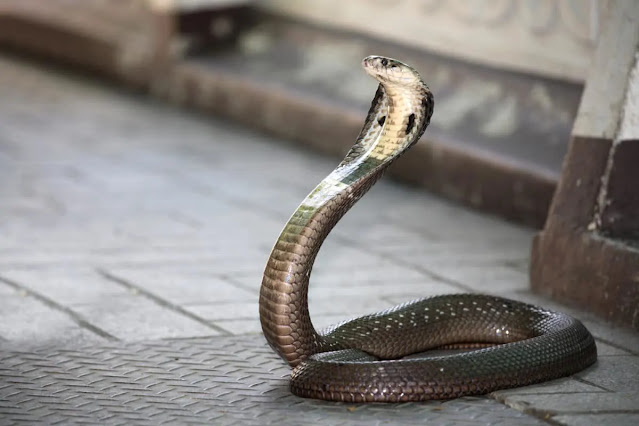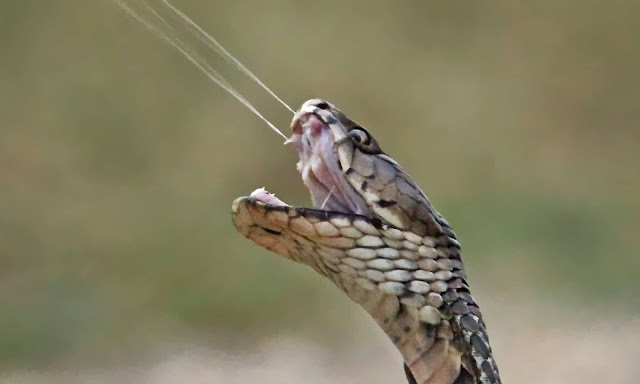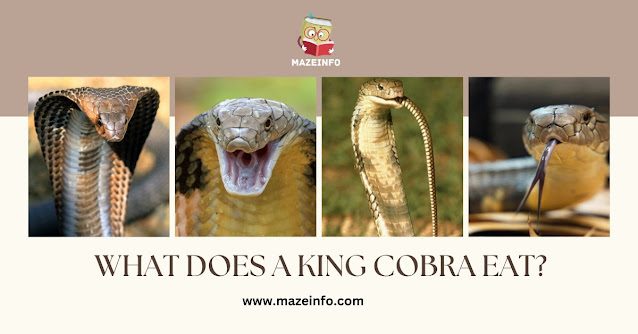In the enthralling realm of serpentine royalty, the King Cobra reigns supreme as an emblem of both fear and fascination. Renowned for its imposing size, potent Snake venom, and regal presence, this magnificent serpent holds an esteemed place in the intricate tapestry of nature. However, beyond its formidable traits, understanding the dietary habits of the King Cobra unravels a captivating narrative, shedding light on its crucial role as an apex predator in the wilderness.
Quick Answer: King Cobras primarily feed on other snakes, such as rat snakes, pythons, and even venomous species. However, they may occasionally consume other reptiles like eat lizards and small mammals when opportunities arise.
Embodiment of Majesty: King Cobra Unveiled

The world of serpents boasts a diverse array of species, each with its own distinct allure. Among these, the King Cobra stands unparalleled, a creature of both fascination and trepidation. Its physical prowess, characterized by a commanding size and unmistakable hood, defines it as the sovereign among snake charmers.
Introduction to the King Cobra
The King Cobra (Ophiophagus hannah) commands attention not only for its awe-inspiring appearance but also for its widespread presence across a variety of ecosystems. Spanning the lush rainforests of Southeast Asia to the dry plains of the Indian subcontinent, this serpent’s habitat diversity echoes its adaptability and resilience.
Exploring Physical Characteristics
Standing as the longest venomous snake globally, the King Cobra often reaches lengths of up to 18 feet (5.5 meters). Its distinct hood, when raised, serves as both a warning signal and an emblem of its regal authority. With scales reflecting a range of colors – from olive green to deep black – the King Cobra presents an intimidating yet captivating visage.
Cultural Significance
Across numerous cultures and mythologies, the King Cobra embodies various symbols. Revered in some societies as a deity’s incarnation, feared in others for its lethal capabilities, this serpent’s presence is deeply woven into folklore, religion, and local beliefs. Its mention in ancient texts and tales underscores its enduring significance in human history.
The King Cobra’s striking presence, habitat adaptability, and cultural eminence paint a portrait of a serpent that transcends mere biology, a creature deserving of both respect and deeper understanding.
A Predator’s Palette: Understanding the King Cobra Diet

The King Cobra’s reign as a majestic serpent extends beyond its formidable appearance. Central to its prowess as an apex predator lies its carnivorous nature and distinct dietary preferences. Unraveling the intricacies of its diet unveils a captivating narrative of survival and specialization in the wild.
Embracing Carnivory
The King Cobra’s dietary habits are firmly rooted in its carnivorous nature. As a top predator, its sustenance relies predominantly on a diet consisting of other reptiles, amplifying its role as a regulator of reptilian populations within its habitat.
An Array of Prey Species
With a diverse palate, the King Cobra’s menu includes a spectrum of potential prey. Primarily targeting snakes such as rat snakes, pythons, and even other venomous species, it displays a marked preference for its reptilian counterparts.
The Role of Venom in Predation
The King Cobra’s lethal venom, infused with neurotoxins, plays a dual role in predation. Beyond subduing prey, it facilitates the digestive process by initiating the breakdown of tissues, highlighting the intricate interplay between its venomous arsenal and dietary habits.
Gourmet Delights: Prime Selections on the Menu
The King Cobra’s discerning palate extends beyond a mere preference for reptilian fare, offering a fascinating glimpse into its dietary nuances. Unraveling the specific prey choices and occasional deviations from the norm illuminates the complexities of this majestic serpent’s feeding behavior.
Primary Prey Selections
Among its favored choices, certain snake species occupy a prominent place on the King Cobra’s menu. Rat snakes, kraits, and even other venomous snakes often constitute the primary prey, reflecting both preference and ecological significance within their shared habitat.
An Unconventional Taste
While snakes dominate their diet, the King Cobra occasionally exhibits opportunistic behaviors, diversifying its diet to include other reptiles such as lizards or even small mammals when circumstances permit, showcasing adaptability in the face of varying prey availability.
Exploring Opportunistic Feeding
Instances of unique prey selection or unconventional feeding behaviors shed light on the adaptability of the King Cobra. Infrequent instances of feeding on other types of vertebrates underscore its ability to capitalize on unexpected opportunities in the wild. The King Cobra’s selective dietary habits and occasional deviations from its primary prey highlight its adaptability and the complex interplay between choice, availability, and survival strategies in the natural world.
Also, Read More: Hosting A Memorable Boba Tea Party
Cobra vs. Others: Comparative Diet Analysis
| Snake Species | Diet | Differences from King Cobra | Similarities with King Cobra | Ecological Impact | Evolutionary Adaptations |
| King Cobra | Mostly snakes (including other cobras), sometimes rodents, lizards, and birds | Preys mostly on other snakes, known to consume other vertebrates occasionally | Shares preference for snakes as primary diet | Plays a role in regulating snake populations, potentially affecting biodiversity | Venomous and efficient predator, capable of taking down larger prey |
| Indian Python | Mammals (deer, rodents), birds | Primarily feeds on mammals and birds | Varied diet but lacks emphasis on snakes | Competition for prey resources; adapts to different prey availability | Ability to constrict prey; slower metabolism for infrequent feeding |
| Black Mamba | Small mammals, birds, and sometimes other snakes | Focuses on smaller mammals and birds | Similar preference for some avian prey | Potential overlap in prey choice, competitive interactions affect survival | Highly venomous, swift, and agile for hunting smaller prey |
| Rat Snake | Rodents, birds, eggs | Primarily consumes rodents and birds | Lack of preference for other snakes | Helps control rodent populations, ecological balance in agricultural areas | Excellent climbers, adapt to various environments and prey sources |
This comparison showcases differences and similarities in dietary preferences among these snake species. The variations in diet can impact the ecological niche by affecting prey populations, influencing competition, and potentially shaping biodiversity within their habitats. These dietary differences have likely driven specific evolutionary adaptations, such as venom efficiency, constriction abilities, or adaptations for specific prey capture methods.
Hunters’ Arsenal: Strategies and Adaptations

The King Cobra’s predatory excellence stems from a blend of refined tactics and specialized physical traits.
Hunting Techniques
Utilizing ambush tactics or actively tracking prey, the King Cobra employs a strategic approach for maximum hunting success.
Sensory and Physical Adaptations
Enhanced senses of smell, sharp vision, and the ability to detect vibrations aid the King Cobra in locating and swiftly striking its quarry.
Ecological Impact
As an apex predator, the King Cobra plays a crucial role in controlling reptilian populations, maintaining ecological balance within its habitat.
Threats and Conservation: Protecting the Regal Predators
Despite their status as apex predators, King Cobras face an array of challenges that jeopardize their survival. Understanding these threats and advocating for conservation measures is crucial to safeguarding these majestic serpents and preserving their critical role in the ecosystem.
Challenges Faced by King Cobras
- Habitat Loss: Rapid deforestation and human encroachment diminish the King Cobra’s natural habitats, restricting their range and access to prey.
- Illegal Wildlife Trade: Targeted for their skin, venom, and traditional medicinal purposes, King Cobras fall victim to the illicit wildlife trade, leading to population declines.
- Human-Animal Conflict: Misunderstandings and fear often result in human killings of King Cobras, contributing to their dwindling numbers.
Importance of Conservation Efforts
- Habitat Protection: Preserving and restoring vital habitats is essential for ensuring suitable environments for King Cobras to thrive.
- Community Engagement: Educating local communities about the importance of these apex predators helps foster coexistence and support for conservation efforts.
- Legal Protections: Enforcing strict laws against poaching and illegal trade, along with promoting sustainable practices, is crucial for their preservation.
Urgency in Conservation
The decline of Cobra Venom populations poses a significant threat not just to the species itself but also to the delicate balance of their ecosystems. Urgent and concerted conservation actions are imperative to secure the future of these iconic serpents. Safeguarding Cobras Eat through conservation initiatives is pivotal not only for their survival but also for the preservation of biodiversity and the health of their ecosystems.
Conclusion
The King Cobra’s regal stature and predatory prowess paint a portrait of a serpent integral to our ecosystems. Unveiling its dietary habits highlighted a carnivorous nature centered around snake species, while its role as an apex predator emerged as a cornerstone in ecological balance. Threats like habitat loss and illegal trade imperil these majestic creatures, urging immediate conservation actions. Preserving the King Cobra ensures not only the survival of a remarkable species but also the preservation of biodiversity within its habitats. As guardians of our natural world, it falls upon us to secure the legacy of the King Cobra, a symbol of awe-inspiring beauty and ecological significance.
Frequently Asked Questions
Q: Why do King Cobras prefer to eat other snakes?
Ans: Their preference for snakes is due to their abundance in their natural habitat. King Cobras play a vital role in controlling reptilian populations, contributing to the ecological balance within their ecosystems.
Q: How does the King Cobra hunt its prey?
Ans: King Cobras employ various hunting strategies, including ambush tactics and actively tracking their prey. They use their keen senses, such as sharp vision and the ability to detect vibrations, to locate and strike their quarry swiftly.
Q: What role does venom play in the King Cobra’s diet?
Ans: The venom of King Cobras serves both as a means of subduing prey and aiding in the digestion process. It contains potent neurotoxins that paralyze the prey, allowing the Cobra to consume it more easily.
Q: Are King Cobras endangered due to their diet or hunting habits?
Ans: While King Cobras play a crucial role as apex predators, they face threats such as habitat loss, illegal wildlife trade, and human-animal conflicts. These challenges pose greater risks to their survival compared to their natural dietary habits.
Q: How can conservation efforts help protect the King Cobra’s diet and survival?
Ans: Conservation measures, including habitat protection, community engagement, and stringent laws against poaching and illegal trade, are essential to safeguard the King Cobra’s existence and ensure the preservation of their prey sources and ecosystems.



